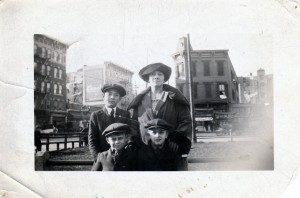Where we last left off in 1920, Hungarians Eugene and Anna had a new life in the Bronx, and three kids – Albert, Eddie and Alex (my Dad). They were age 35 and 30, and the boys were 11, 8 and 5. They may have lost their bar when Prohibition came in, but they went on to run Kardos Garage, on West 127th street.
The American teetotal “Eighteenth Amendment” was approved early in 1919, giving the nation one year to brace itself. The USA went dry one year later, on January 17, 1920. Eugene bought the garage, and the Assignment Of Mortgage was listed in the New York Tribune on January 15, just two days earlier. He seems to have thought ahead on this one. How they disposed of the bar is not yet known, but rumour says running it purely as a café, did not work.
When we got to this point in the story, it still wasn’t clear exactly how Eugene got from Hungary to New York, when he was just 22. Wife Anna’s journey’s documentation had a few inconsistencies and questions, but as for records of Eugene, I found nothing.
People did sneak in, under the radar. This was said about my other granddad, the Latvian. There isn’t a scrap of info on his arrival. He was a cook on a Russian merchant ship, who got to New York that way and allegedly he simply didn’t get back on board. That’s a set of rumours for another day.
Here, Eugene Charles Kardos’s trail stopped cold, blocked by my ignorance of his native tongue and his now Anglicised name. I was raised in New Jersey. I didn’t speak Hungarian. What was the Hungarian version of Eugene?
The phrase “Find my Hungarian family” on the internet sends you to an informed, active, helpful bunch of people called “The Hungarian Exchange – Genealogy”, or
https://www.facebook.com/groups/HungaryGenealogy/
They’re speedy, too.
In minutes, as I remember, I was a more informed person. In Hungarian, Eugene is spelled “Jeno”, and pronounced “Yeno”. I found no Jenos, over a ten year span, but there was one Yeno, all of whose data fit. Maybe his first New Yorker, the immigration official, wrote it Yeno because it sounded that way. Or he wrote his Js strangely, but the transcriber certainly wrote Y, which is where he was listed, with the Ys. In any case, this looks like him here, on the Ship Manifest of the Pannonia, which sailed from Fiume (formerly Italy, then Croatia) in 1905.
Kardos, Yeno. 22 year old single male, Hungarian Magyar. Occupation – merchant. Can read and write. He had never been here before, and he had the required minimum $50 and not a penny more. He was staying with Rudolf Kohn, 208 East 95th street. He was neither pauper, madman, anarchist nor polygamist, and he was healthy in mind and body. 5 foot 5, light skin, dark hair, blue eyes. No other marks of identification. Born in Budapest.
That ship was not the massive monstrosity on which Anna arrived, carrying a few thousand people. The Pannonia carried 80 first class and 800 third class passengers. It was built in Glasgow because every ship in the world seems to have been built by Scots, in those days.
We’ll probably never work out how he and Anna met, and I can’t yet find a marriage certificate. But, since this part of the Bronx was brimming over with Hungarians, that’s enough of an answer for now. Although they would move house a few times in their lifetime, they would never go far from this neighbourhood.
By the way, I love Wikipedia’s definition of a “ship’s manifest”, a term I’d never heard before. It’s a list of who and what’s on board, on arrival, used “to ensure that passengers and cargo placed on board at the beginning of its passage, continue to be on board when it arrives at its destination.”
We continue to be on board this voyage, which will continue next time.



0 comments
No comments yet